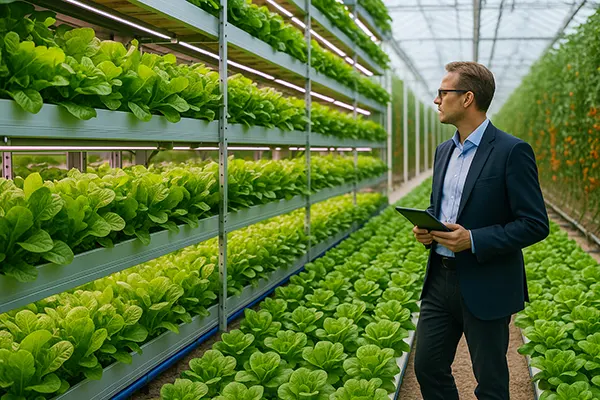
Investing in Food Security: Agricultural Projects, Vertical Farms and New Portfolio Opportunities
In 2025, food security has evolved from a humanitarian priority into a key financial theme. As global challenges such as climate change, geopolitical tension, and supply chain instability reshape economies, investors are discovering that agriculture and technology can be both profitable and socially impactful. The sector’s modernisation through innovation opens a wide range of opportunities – from smart farming and sustainable food production to green investment portfolios.
The Investor’s Perspective on Food Security
Food security refers to the availability, accessibility, and sustainability of safe food for the world’s population. For investors, this translates into a sector driven by necessity rather than fashion. The demand for efficient food production, storage, and distribution systems is rising alongside population growth and shifting consumption habits. As a result, capital directed into this industry plays a dual role: it generates returns and supports global stability.
From a portfolio standpoint, food security investments are long-term and resilient. Unlike volatile technology or speculative assets, agriculture and food infrastructure often show steady performance, even during economic downturns. They act as a hedge against inflation and geopolitical risks, making them attractive to both institutional and retail investors.
In 2025, sustainability criteria are now central to investment decisions. Environmental, Social, and Governance (ESG) frameworks guide fund managers toward companies that promote resource efficiency, ethical labour practices, and reduced emissions. This makes food security not just a moral choice, but a modern financial strategy.
Technological Drivers: From Vertical Farms to Agro-Robotics
Technology has transformed agriculture into one of the most innovative fields in the modern economy. Vertical farming – where crops grow in stacked layers under controlled environments – is revolutionising urban food supply chains. These systems reduce water consumption by up to 90% and eliminate the need for pesticides, making them environmentally sustainable and economically scalable.
Hydroponics and aeroponics further enhance productivity, allowing plants to grow without soil using nutrient-rich solutions and oxygenated mist. Combined with renewable energy sources and automated monitoring, they reduce dependency on weather and transport, increasing resilience during climate-related disruptions.
Agro-robotics, drones, and data analytics are also reshaping how food is produced. AI-driven precision farming helps optimise fertiliser use, monitor soil health, and forecast yields. These innovations improve profitability while reducing waste, aligning economic gains with ecological responsibility.
Investment Instruments in the Agricultural Sector
Investors seeking exposure to food security have a variety of instruments to choose from. Traditional options include purchasing shares of listed agribusinesses such as Deere & Company, Archer Daniels Midland, or Nutrien. These firms are investing heavily in automation, crop genetics, and supply chain modernisation.
Exchange-Traded Funds (ETFs) dedicated to agriculture and sustainability have also gained traction. Funds like Invesco Global Agriculture ETF or VanEck Agribusiness ETF allow diversification across multiple regions and segments, lowering individual company risk. Additionally, green bonds and climate-focused funds now include agricultural innovation as part of their portfolios.
Private equity and venture capital play a growing role by supporting emerging startups in agri-tech. These include developers of AI-based farm management systems, vertical farm infrastructure, and biotech solutions that improve crop resilience. In 2025, several European and Middle Eastern sovereign wealth funds have increased their allocations to food technology ventures, reflecting the sector’s global strategic value.
Risks and Evaluation Metrics
Despite its promise, investing in food security carries specific risks. Weather extremes, disease outbreaks, and political regulation can affect production and pricing. Climate adaptation measures and insurance instruments are therefore essential components of a sound strategy. Investors must also consider biosecurity standards and environmental compliance to mitigate reputational risk.
Regulatory frameworks vary widely across jurisdictions. For instance, European investors must comply with the Common Agricultural Policy (CAP) and ESG disclosure requirements, while in Asia, food technology is often linked to urban development incentives. Understanding regional differences is key to managing exposure effectively.
Evaluating agricultural companies requires metrics beyond standard financial ratios. Key Performance Indicators (KPIs) include cost per yield unit, water and energy efficiency, land productivity, and carbon intensity. Profit margins are often moderate but stable, with long-term growth depending on innovation capacity and sustainable operations. Investors are advised to analyse operational transparency and R&D expenditure as indicators of competitiveness.

Global Outlook and Strategic Implications
The future of food security investment is closely tied to global demographic and environmental trends. By 2030, the world’s population will surpass 8.5 billion, intensifying pressure on agricultural resources. Urbanisation and shifting diets toward plant-based and alternative proteins are changing market dynamics, creating opportunities for forward-looking investors.
Governments are increasingly supporting innovation through subsidies and public-private partnerships. In the European Union, funding for sustainable agriculture and green technology has reached record levels under the Green Deal framework. Similarly, Gulf countries are investing in controlled-environment agriculture to ensure food independence and reduce import dependency.
For investors, diversification across value chains – from farm automation and logistics to biotechnology – will be essential. The most successful portfolios in 2025 combine financial returns with measurable environmental and social outcomes, reflecting a broader shift toward responsible capitalism and long-term resilience.
The Role of Innovation and Collaboration
Innovation is the driving force behind modern food security. The collaboration between governments, investors, and technology firms is creating ecosystems that accelerate adoption of sustainable practices. Data sharing, open research platforms, and blockchain traceability systems are improving transparency and trust in the supply chain.
Startups and universities play a crucial role by developing breakthrough solutions such as gene-edited crops resistant to drought and smart irrigation systems powered by AI. These technologies not only address food shortages but also enhance efficiency across agricultural ecosystems.
Ultimately, food security has become a defining theme of the 21st century. Investing in this sector is no longer purely financial – it is an ethical and strategic choice aligned with humanity’s collective future.
